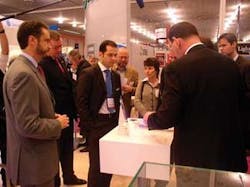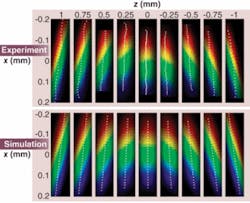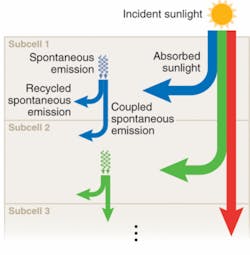CONFERENCE PREVIEW: PHOTONICS WEST 2008: Light it up and they will come… to Photonics West

Sometimes it’s all about the money. But in Silicon Valley at the end of each January, it’s all about the light. North America’s largest photonics event, SPIE’s Photonics West 2008 takes place Jan. 19-24 in San Jose, CA, and is again expected to draw record crowds.
Approximately 17,000 attendees from around the world will flock to four international symposia: Biomedical Optics (BiOS) 2008, emphasizing new developments in biomedical optics technology; Optoelectronics (OPTO) 2008 on integrated optoelectronic devices; Lasers (LASE) 2008, highlighting lasers and applications in science and technology; and Micro-optoelectromechanical systems-Microelectromechanical systems (MOEMS-MEMS) 2008, featuring advances in micro and nano fabrication and technology.
The weeklong event begins with BiOS on the opening weekend-the largest biomedical optics exhibition in the world-and continues with Photonics West running the rest of the week.
According to organizers, the Photonics West exhibit floor will feature more than 1100 companies, compared to 1000 last year, while the convention-center halls will offer more than 3100 technical papers in no fewer than 85 conferences (see Fig. 1). A variety of all-symposium social networking events will be offered, including several designed for students and early-career professionals. Returning attendees know that synergy among the various photonics communities is a large part of the value of the event.
Leading international experts will provide insights via numerous plenary and hot-topic sessions and an industry perspectives panel-with a noticeable increase in communications topics this year.
BiOS
Beginning on Saturday, Jan. 19, the BiOS conference alone will offer 1300 papers, more than any of the other three conferences at Photonics West. The BiOS “Hot Topics” plenary Saturday evening from 7 to 9:30 p.m. will be moderated by Sergio Fantini of Tufts University. Among the planned talks and speakers are Progress in Therapeutic Lasers, given by R. Rox Anderson of the Wellman Center for Photomedicine at Massachusetts General Hospital and Harvard School of Medicine; Imaging and Treatment of Cancer Using Gold Nanoparticles, by Rebekah Drezek of Rice University; Monitoring and Predicting Chemotherapy using Diffuse Optics, by Bruce Tromberg, Beckman Laser Institute and Medical Clinic; and Photoacoustic Microscopy and Computed Tomography, by Lihong Wang, Washington University in St. Louis. Sunday night, the Hot Topics theme continues with workshops on Nanotechnology and Medicine, moderated by Tromberg and Drezek.
In the Clinical Technologies and Systems track of BiOS continuing into Monday, authors Narasimhan Rajaram, Timothy J. Aramil, Kelvin Lee, and James W. Tunnell from the University of Texas (Austin, TX) will discuss their novel, probe-based, portable clinical system for early detection and margin demarcation of melanoma and nonmelanoma skin cancers. The system collects white-light reflectance and fluorescence from tissue in real time (see Fig. 2). In addition to system performance, the team will present preliminary clinical results of a feasibility study to estimate the sensitivity and specificity of real-time diagnosis of skin-cancer malignancy.During BiOS, PennWell (Tulsa, Oklahoma), will announce the launch of BioOptics World magazine and digital brand, a new sister publication to Laser Focus World, with an event (details to be announced) Saturday evening (see www.laserfocusworld.com/articles/306277).
LASE
In the LASE portion of the event, the coverage of ultrafast, solid-state, fiber, and high-power-diode lasers will be dense. An invited paper, “Everything you’ve always wanted to know about an ultrashort pulse but thought was immeasurable,” is planned Monday by authors Rick P. Trebino, Pablo Gabolde, Pamela R. Bowlan, and Selcuk Akturk of the Georgia Institute of Technology (Atlanta, GA). This paper will review the latest results of a measurement technique to characterize the complete spatio-temporal electric field of an ultrashort pulse, called Spatially Encoded Arrangement for Temporal Analysis by Dispersing a Pair Of Light E-fields (SEA-TADPOLE; see Fig. 3; see also www.laserfocusworld.com/articles/294649).“Since the development of the SEA-TADPOLE technique,” explains lead author Trebino, “we’ve discovered that researchers were quite unaware of the degree to which their pulses were distorted near foci.”
An invited paper, “First experimental demonstration of PASER: particle acceleration by stimulated emission of radiation,” by Samer Banna of Brookhaven National Laboratory, consultant Valery Berezovsky, and Levi Schachter of Technion-Israel Institute of Technology (Israel), is also planned for Monday. The presentation will report on the PASER novel acceleration scheme, which directly uses energy stored in microscopic cavities for particle acceleration.
Other invited papers in the LASE conference include, “High-energy femtosecond fiber lasers,” by Frank W. Wise, Andy Chong, and William Renninger of Cornell University (Ithaca, NY) on Tuesday; and “Stopping light via index and loss tuning in coupled resonator systems,” by Sunil Sandhu, Michelle L. Povinelli, and Shanhui Fan of Stanford University (Palo Alto, CA), also on Tuesday. The latter will introduce a light-stopping process that uses dynamic loss tuning in coupled-resonator delay lines.
The LASE All-Conference Plenary session begins Wednesday morning with a presentation by Dieter Bäuerle of Johannes Kepler University (Linz, Austria) entitled, “Laser processing and chemistry: applications in nanopatterning, material synthesis, and biotechnology.” Holger Schlueter, from the Farmington, CT, North-American subsidiary of Germany-based Trumpf, continues the LASE Plenaries with his first-hand experience in his talk, “The long journey from idea to industrial success.”
Laser Focus World will sponsor the annual Lasers & Photonics Marketplace Seminar on Monday, Jan. 21, at the Fairmont Hotel in San Jose. For additional information or to register, visit www.marketplaceseminar.com.
OPTO
The OPTO Plenary “Welcome” presentations take place Tuesday morning with Eli Yablonovitch of the University of California (Berkeley, CA) speaking on “Nanophotonics: from photonic crystals to plasmonics.” The Plenary continues with Niyazi Serdar Sariciftci of Johannes Kepler University Linz, on “Organic ‘plastic’ optoelectronic devices.” Other topics seeing heavy paper submissions at the OPTO conference include: photonic crystals, light-emitting diodes (LEDs), semiconductor lasers, gallium nitride materials and devices, silicon photonics, quantum sensing, and integrated optics.
Anew solar-cell design will be discussed Monday by Yong-Hang Zhang and colleagues at Arizona State University (ASU; Tempe, AZ) in “Impact of photon recycling and spontaneous emission coupling on multijunction solar-cell design.”Traditional multijunction solar-cell models consider radiative recombination a loss. However, spontaneously emitted photons can be reabsorbed inside the junction itself (photon recycling) and by adjacent junctions with lower bandgap energies (spontaneous-emission coupling), both of which reduce the losses associated with spontaneous emission. The ASU group has developed a new model for high-concentration solar-cells that considers both of these effects (see Fig. 4).MOEMS-MEMS
The MOEMS-MEMS Plenary presentations will begin at 9 a.m. on Monday with Michael Douglass of Texas Instruments (Dallas, TX), who will speak on “MEMS reliability: coming of age.” Harold Craighead of Cornell University will follow with “Optically transduced MEMS resonators.” Randy Sprague of Microvision will rap up the MOEMS-MEMS Plenaries with a discussion, “High-resolution displays, one pixel at a time.”
As part of the MEMS Session 3 on Tuesday: MEMS in Homeland Security and Space Applications, John C. McNulty of DfR Solutions (College Park, MD) will give his keynote invited paper, “A perspective on the reliability of MEMS-based components for telecommunications.”
Papers from all the technical conferences, including the Plenaries, will be published online in the SPIE digital library two to four weeks after the conclusion of the conference.
In addition to papers, more than 80 technical courses and professional development workshops will be offered, with topics including Optoelectronic Materials and Devices, Photonics Integration, Nanotechnologies in Photonics, Displays and Holography, Photonic Therapeutics and Diagnostics, Clinical Technologies and Systems, Tissue Optics, Laser-Tissue Engineering, Nonlinear Optics, and Standards.
With more to offer than most three-ring circuses, Photonics West remains one of the most important annual events for optoelectronics researchers and businesses. “Photonics West effectively bridges every aspect and facet of the photonics industry. The event also has the benefit of dovetailing with BiOS, which has increased our biomedical optics business tremendously,” says Michelle Young, sales and marketing manager, OptoSigma (Santa Ana, CA).
The week following Photonics West, SPIE continues the madness with its Electronic Imaging conference; view details at electronicimaging.org. To preview and search the Photonics West advanced program or to register for any of the week’s events, visit spie.org/photonics-west.xml.
About the Author
Valerie Coffey-Rosich
Contributing Editor
Valerie Coffey-Rosich is a freelance science and technology writer and editor and a contributing editor for Laser Focus World; she previously served as an Associate Technical Editor (2000-2003) and a Senior Technical Editor (2007-2008) for Laser Focus World.
Valerie holds a BS in physics from the University of Nevada, Reno, and an MA in astronomy from Boston University. She specializes in editing and writing about optics, photonics, astronomy, and physics in academic, reference, and business-to-business publications. In addition to Laser Focus World, her work has appeared online and in print for clients such as the American Institute of Physics, American Heritage Dictionary, BioPhotonics, Encyclopedia Britannica, EuroPhotonics, the Optical Society of America, Photonics Focus, Photonics Spectra, Sky & Telescope, and many others. She is based in Palm Springs, California.



